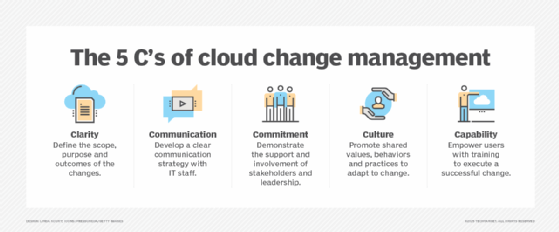
Getty Images
The 5 C's of cloud change management
Cloud change management is vital for smooth IT transitions. It involves clarity, communication, commitment, culture and capability to ensure successful cloud deployments.
Implementing cloud and cloud services is an ongoing process that requires continuous management and oversight. How can organizations simplify cloud change management?
Cloud change management is a continuous process for controlling the lifecycle of cloud service adoption. Once in place, business leaders and IT administrators can control and oversee each stage of implementation with minimal disruption to existing IT services. Whether an organization plans to migrate its applications to the cloud or undertake organizational IT or compliance changes, it can ensure a solid foundation in an ever-changing commercial and IT landscape with the five C's of cloud change management:
- Clarity.
- Communication.
- Commitment.
- Culture.
- Capability.
These comprehensive and interconnected strategies remove roadblocks, minimize disruptions and facilitate successful deployments.
1. Clarity
Cloud change management requires a holistic approach that covers everything from maintaining compliance with regulatory changes to offsetting deployment impacts on users. A readiness assessment can gauge preparedness, evaluate existing IT infrastructure, and determine the suitability of applications, data and processes for cloud migration. Such an assessment and preparedness can help avoid unnecessary spending. Moreover, taking an agile approach that prioritizes flexibility and fast adaptation can provide IT teams with the clarity needed to deploy complex data migration and monitoring tools effectively.
IT leaders need to develop a clear roadmap that will set the pace for cloud adoption, offset change fatigue and ensure the right cloud services are in place. Additionally, they should identify potential obstacles early in the cloud adoption process, such as budget constraints or skill gaps, for a smooth transition.

2. Communication
For a successful cloud adoption process, include employees at the start and develop a clear communication strategy with regular updates and feedback mechanisms. The goal is to collect end-user input at every step of cloud planning, testing and deployment.
The result is a smoother transition with cloud features that meet the users' and IT teams' specific needs and workflows. Timely audits offer a means to analyze adoption patterns across an organization based on usage and user experiences. Internal assessments can provide data to address the rate of uptake, target places for new workflows or features and improve integrations.
3. Commitment
Organization leaders are in a prime position to clearly define and communicate cloud goals. Moreover, the involvement of business and IT team members at each stage of the cloud change management process will encourage buy-in. Clear C-suite and IT commitment is critical to mobilizing a workforce to ensure adoption success.
It's also important to provide resources that demonstrate an organization's commitment to cloud change. Implementing an internal chatroom focused on adoption can provide a forum for user feedback, and in-house and vendor-based training offers employee resources and support.
4. Culture
Business culture consists of the overall working environment within an organization and the shared set of values, beliefs and practices that shape interactions affecting business decisions. Leaders should be forward-thinking and consider a range of cloud deployment models that will provide process innovation and encourage openness to change.
Business and IT environments must capitalize on collaboration, flexibility and scalability. Strong cross-team communication reinforces business continuity and best practices. Organizations can accelerate cloud adoption by decentralizing the change approval process. Peer-reviewed changes that teams conduct are often more effective for risk optimization than panel advisory boards, which can create bottlenecks and slow down change.
5. Capability
Once an organization begins its transition to the cloud, customize training to meet the needs of specific user groups. Hands-on workshops boost confidence and offer practical experience for using individual cloud migration tools, dashboards and vendor-proprietary workarounds.
Organizations can ensure that employees have the capabilities to use new cloud-based functionality in their business roles by empowering users with vendor-specific training. Companies benefit not only from customizing training programs to meet the specific needs of user groups but also from offering continual support, ensuring that end users stay current with any cloud service changes.

Explore cloud change management tools
When considering cloud change management tools, a primary goal is to ensure cloud service compatibility with existing IT infrastructure for smooth integrations, scalability, security and compliance. The most effective change management tool provides a high degree of control, easy access and shared responsibility to ensure that data and applications are functional and secure.
Below is an unranked, alphabetical list of four popular change management tools chosen based on market research:
HaloITSM
HaloITSM offers unlimited customizations to ease cloud change management processes. Featuring robust support services, IT teams can use the cloud-based platform to plan, track and implement changes across multiple clouds. Focused on ITIL best practices, HaloITSM offers a stable and intuitive structure for handling all aspects of cloud change management.
Freshservice
Freshservice provides a cloud-based SaaS service with a dedicated cloud change management feature. Administrators can use the structured workflows within the "Change Lifecycle" component to manage the entire change process. Intuitive to work with, Fresh Service provides numerous integrations with popular management tools, including Slack, Jira, Microsoft Teams, SecPod and Azure AD.
Jira Service Management
JSM offers built-in functionality and automates many cloud change management tasks related to assessments, approvals and change requests. The platform tracks and documents workflow changes and provides fast navigation between linked projects, issues, requests and changes. Time-saving document trails simplify the process of identifying actions and issue resolution.
ServiceNow
ServiceNow provides PaaS cloud change control. It offers workflow automation to manage changes, coordinate approvals, track cloud implementation and identify cyber risks and unauthorized access. A comprehensive platform at a premium price, ServiceNow offers customization and requires significant IT experience to implement its numerous features and manage cloud changes.
Kerry Doyle writes about technology for a variety of publications and platforms. His current focus is on issues relevant to IT and enterprise leaders across a range of topics, from nanotech and cloud to distributed services and AI.







